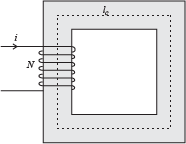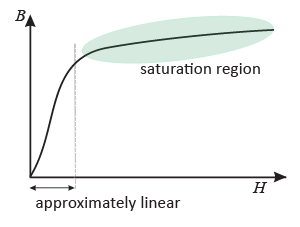Review of Electromagnetic Fields
Electrical machines are based on the electromagnetic principles that produce force or induce voltages and currents. Electromagnetic fields provide the link between mechanical systems and electrical systems. There are five principles that allow us to understand this link.
- Current flowing in a conductor will produce a magnetic field around the conductor.
- Magnetic materials, with high relative permeability, provide a means to direct and focus magnetic flux
- Transformer Action: If the magnetic flux passing through a coil changes, there will be a voltage induced in the coil.
- Motor Action: If current flows in a conductor subject to an external magnetic field, a force will be exerted on the conductor.
- Generator Action: If a conductor is moved through a magnetic field a voltage will be induced in the conductor.
Production of a Magnetic Field
Ampere's Law states that:
i.e. the total current I enclosed by the path c is equal to the integration of magnetic field intensity along that path. Note that \(\vec{H}\) denotes that magnetic field intensity is a vector, H is the magnitude of the vector.
Consider Ampere's Law applied to the simple magnetic core shown in the figure. Here, there is a core with average length lc with a coil of N turns on one side. The coil carries a current i. In this case the total current enclosed by the path following the dotted line is given by
Applying Ampere's Law we get:

We can think of Ni as the driving force which drives flux around the magnetic circuit. Ni is the magnetomotive force, or mmf, denoted by \(\mathcal{F}\). Assuming that all the flux stays in the iron core and that the core has a cross section A, then we can say that the magnetic flux density \(\vec{B}\) can be written as:
\(\phi\) is magnetic flux and \(\mu\) is magnetic permeability. \(\mu = \mu_0 \mu_r\) where \(\mu_0\) is the permeability of free space and \(\mu_r\) is relative permeability. For unsaturated steel, \(\mu_r\) is typically in the range of about 5,000 - 10,000. Re-arranging the above equations, we get:
where \(\mathcal{P}\) is called the permeance of the magnetic circuit. Alternatively we can write:
Where \(\mathcal{R}\) is reluctance and \(\nu\) is reluctivity. Comparing the magnetic circuit to an electrical circuit, flux is analogous to current, reluctance is analogous to resistance and mmf is analogous to emf, or voltage. Using this approach we can calculate the reluctance of various sections of a flux path to calculate the flux and flux density
Recap
So far:
- We can create a magnetic field using current and conductors.
- If we coil the conductors with N turns, the magnetic field intensity will increase by the factor N.
- We can direct the path of the magnetic field using ferromagnetic materials (with high relative permeability).
- We can consider an electromagnetic circuit as analogous to an electrical circuit.
Gapped Core
Now we can consider Ampere's Law applied to the air-gapped magnetic core shown in Fig. 2.
The source mmf from the coil is given as
where \(\mathcal{F}_c\) and \(\mathcal{F}_g\) are the MMF applied to the core and the air gap respectively.

Using the magnetic circuit approach the mmf equation can be written as
and if we assume fringing is negligible, \(A_g=A_c\) then
The above equations indicate that the flux density produced is a function of the MMF amp-turns, the air gap length, the steel core length and the steel relative permeability. If the relative permeability of steel is high (10,000) then the core MMF in the core will be negligible relative to the MMF in the air gap. In this case, to acheive a high flux density, we simply need a small gap, or a high MMF. Unfortunately, the permeability of steel falls as the flux density increases.
Saturation
A typical magnetisation characteristic, or BH curve, for steel is similar to the one in Fig. 3. The permeability is given by the ratio \(B/H\).
Increasing the magnetic field intensity will initially cause a rapid rise in flux density This indicates a high permeability. At some point (typically about 1.0T to 1.5T in steels used in machines) the rate of increase of flux density with field intensity is reduced. This is called the knee of the saturation curve. As the field intensity is increased further the steel is said to be saturated and larger changes in field intensity result in smaller changes in flux density. As a result, the flux density in electrical machines is limited. We will see later that force and torque are functions of flux density and dimensions. Since flux density is limited, we are left with the fact that a higher torque requires a larger machine. This is an important general result. It means that higher speed machines are smaller for a given power rating (power is torque times speed). It also means that to reduce the size of a machine for a given torque, you must somehow increase the flux density.

Transformer Action
Faraday's and Lenz' Laws state that
If the flux passing though a a single turn of a wire changes with time, there will be an emf induced in across the turn, and the emf induced will act to induce a current opposing the change in flux.
If a single wire is arranged so as to form a closed loop, it is called a 'turn'. A number of turns of wire together form a 'coil'. Coils can often be though of as having 2 'coil-sides', i.e. positive current may flow away from you in one side of the coil and towards you in the other side of the coil. A number of coils may be connected form a 'winding'.
In a coil the total flux passing through the coil (linking the coil) will be the sum of the flux linking each turn of the coil. Often this is approximated as the number of turns multiplied by the flux linking one turn. However, it is more correct to think of the total flux linkage of a coil, denoted by λ. Flux linkage has units of Weber-turns. In this case we re-write the induced voltage as:
Motor Action
A force is produced when current flows through a conductor in a magnetic field. Note that if the current flow parallel to the direction of the magnetic flux, the force will be zero.
Force is a maximum when current flow is perpendicular to flux density.
Generator Action
Moving a conductor through a magnetic field will cause a voltage to be induced in the conductor. Note that in the above equation, \(v\) denotes linear velocity.
Induced voltage is maximized when the conductor, flux density and motion are perpendicular to one another.
Summary
The ability to create a magnetic field using coils and electric current can be combined with ferromagnetic materials to direct and focus magnetic flux. Combined with transformer action, generator action and motor action, these concepts form the foundation of electrical machine design and operation.